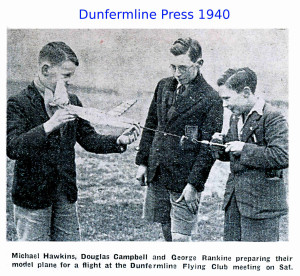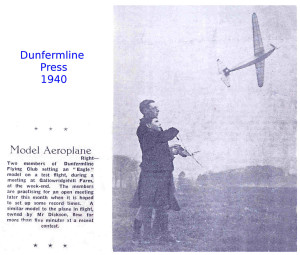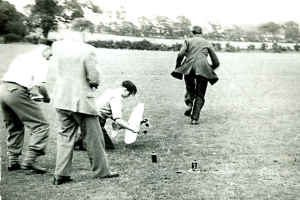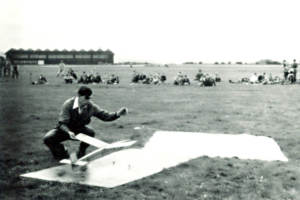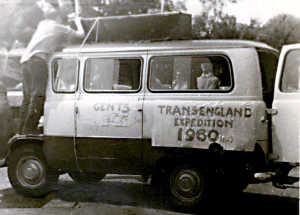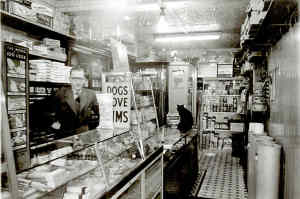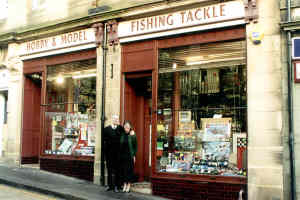DMAC was founded in 1936 with many schoolboys in the ranks. One of them, Douglas Campbell is a member to this day!
The club flying site was Gallowhill Farm, Wester Gellet just South of Dunfermline. Models flown were all free flight, mainly rubber powered or glider since model engines were few and far between and very expensive.
With the start of the second world war in 1939 activity was curtailed with many of the seniors being called up. The juniors however continued to fly and competitions were held as reported by the Dunfermline Press in 1940.
The end of the war and return of seniors resulted in a resurgence in activity. In 1946 members included Dave Brown, George Simpson, Ian Donald, Jock Anderson, “Piggy” Greenwood, Bob Hutton, Scott Elliot, Bill Murry, Micky Ventners, Steve Anderson.
By 1949 control line flying had reached the UK from the USA where it was known as U control. Model engines were now more freely available and so DMAC members started to learn this new discipline.
In the 50s FF was flown at Lathalmond on a rough field opposite the then Naval Depot, now the Scottish Bus Museum.
Permission to fly on the playing fields at Pitrieve was granted to the club by the Carneige Trust and so both Free Flight and Control line models were flown. Bill Murray was flying the Rubber powered “Wakefield” class, named after Lord Wakefield of lubricating oil fame, later to become Castrol. Dave Brown and Ian Donald flew FF Open Power. The fields were much less hemmed in then with open ground to the West, South and East thus making them suitable for wayward FF models. Also the surrounding trees sometimes prevented models from straying outside the field as shown by Dougie Groome’s “Caprice” glider.
The playing fields were subsequently transferred to Fife Council but the club retained the right to fly. Later still private operators took over but the permission was incorporated into the lease.
Venturefair playing fields were also used for control line with George Simpson flying “Happy Harold” and Bill Robertson “Mills Bomb” named after the Mills engine popular at the time.
In 1951 the Caledonian Model Shop in Glasgow donated a tropy to the Scottish Aeromodellers Association. The “Caledonia Shield” was for club teams flying both FF duration and CL aerobatic models. Dunfermline won this shield in the inaugural year , Bill Greive being the individual champion in the CL aerobatic events. The club has won the shield no less than 12 times since and is the current holder (2014).
By 1950 the club was using the “bat” logo and members sporting club shirts were going further afield for competition with trips to both Scottish and British National championships. The Scottish “Nats” were held at RAF Abbotsinch, now Glasgow airport.
A notable International competition success was when Ian Donald won FF Power duration event in the KLM trophy held in the Netherlands,
The introduction of CL flying to the club enabled members to display their skills to a wider public. An example of this was the Navy fair held at the Rosyth Port admiral’s house with CL flying taking place on the tennis courts.
A popular haunt of members when not flying was David Blacks model shop in Dunfermline high street.
The shop moved to the New Row in 1955 and was subsequently taken over by David junior and Maureen Black. Club members have fond memories of Mrs Mallison who was particulary good to the Juniors. The members reciprocated by using their engine starting skills when a troublesome motor was handed in by a newcomer to the hobby. The New Row shop closed in 2001
During this time the club used a number of rooms around the town. The first of these was in Woodmill road nearly opposite the Post Office sorting office in a building where the Surgery now is. George Simpson had obtained a number of drawing boards from the High School and these were put to good use by the juniors as building boards. The club also bought materials in bulk and sold them on at a good price to support the juniors.
A move was made to Mid Beveridgewell. This club room had ledgendary electrics which were fed from the house next door through a hole in the wall!
The late 50s saw a number of members leave the junior ranks and go South to seek their fortune. Pete Brown flying FF power with Dixilanders and Bill Greive flying CL were amongst this exodus from the club. They were both to some return years later.

